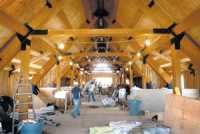Building improvements, relocation of the primary parking lot and a new restaurant and gift shop are giving Crater Lake National Park…A new look
The Mail Tribune
Medford, Oregon
July 28, 2006
By Bill Kettler
 |
| The remodeled cafeteria building at Crater Lake National Park will have an interpretive center on the second floor with large windows that will look over the lake. (Mail Tribune / Jim Craven) |
Crater Lake hasn’t changed much in the past thousand years, but if you haven’t visited Oregon’s only national park for a year or two, you can’t help but notice that things look different there.
Mounds of soil cover what used to be a parking lot where most visitors caught their first glimpse of the deepest lake in North America.
Several structures among the collection of buildings known as Rim Village have been demolished, and others are being remodeled. A few miles away, near the park’s south entrance station, a brand new restaurant and gift shop have opened.
The work is part of a project designed to give visitors a more natural encounter with the lake, reduce vehicle traffic and congestion at the rim and create a more harmonious architectural style among the buildings, said Michael Justin, a park spokesman. The plan also includes a new restaurant and gift shop near the Annie Springs entrance station that is intended to lure visitors off the rim when they want to have a meal or buy a souvenir.
All the construction is part of a visitor services plan drafted by the National Park Service in the 1990s, said Dominie Lenz, general manager of the park concessions for Xanterra Parks & Resorts, the park’s concessionaire.
“The goal is to direct traffic congestion from Rim Village and push visitors to other areas of the park,” Lenz said.
The most noticeable changes are focused at the cluster of buildings where the paved road reaches the rim. The old parking lot is gone, covered for now with construction equipment and building materials, and a new parking lot has been constructed behind the buildings. Visitors will walk to the lake along paths across the old parking lot, which will be revegetated with native plants and trees, many of which were removed from other areas during construction and will be replanted on the former parking lot.
Justin said the old parking arrangement was unsafe because visitors had to dodge vehicles to reach viewpoints along the rim. Moreover, crossing an asphalt parking lot to approach the lake diminished the sense of awe in seeing the lake.
The rim’s main visitor services building, which housed the cafeteria and gift shop, is getting new entrances and new dormers on the top floor to bring more light into what was otherwise a poorly lit space. Several additions that were tacked onto the building have been removed, and the structure that remains will be remodeled to provide limited deli-style food service and office space for Xanterra, as well as an interpretive center on the second floor, where large windows will offer a view of the lake across the revegetated parking lot.
The roof will be covered with 12-inch styrofoam panels to insulate the structure against extreme winter weather at 7,000 feet, then covered with cedar shingles to maintain its original character.
A new “snow tunnel,” faced with stone, will provide a protected entrance into the building from the new parking lot during winter months when as much as 15 feet of snow covers the rim.
The parking lot work and building renovations were bid at $5.8 million, said J.D. Palaniuk, of PSBS&J, a construction firm that is working as a liaison between the Park Service and other contractors. Palaniuk said the project is scheduled for completion by late Dec. 24.
The new restaurant was built adjacent to the Mazama campground, the only developed camping area within the park, and was designed to blend with the rustic architecture that is associated with Crater Lake’s historic Park Service buildings, said Scott Dinges, Xanterra’s engineer at Crater Lake. The building features a steep, high roof to shed the deep snow that buries the park in winter, clear cedar siding and stone facing that echoes the foundations of the park’s earliest buildings.
Inside, there are artisan-crafted chandeliers and sconces and a stone fireplace that evokes Wizard Island and the steep rim of the caldera. Post-and-beam construction frames the buffet line, with the posts set in pillars of dry-laid stone. Furniture is camp-style rustic.
Dinges said Xanterra used modern eco-friendly materials and energy efficient designs wherever possible with the goal of earning recognition from the U.S. Green Building Council’s “Leadership in Energy and Environmental Design” program. The roof, for example, is sheathed with “shakes” made from a composite rubber/vinyl material that gives the look of cedar shakes without cutting trees, and the carpet is made from recycled materials.
Lenz, Xanterra’s general manager at Crater Lake, said the $3.2 million restaurant/gift shop may become the first structure in a national park to win certification as an environmentally friendly building from the Green Building Council. The restaurant has been open since spring, but a grand opening is scheduled for Aug. 4. The building at the rim is scheduled to reopen to the public next May, when spring comes to Mount Mazama.
Other pages in this section

